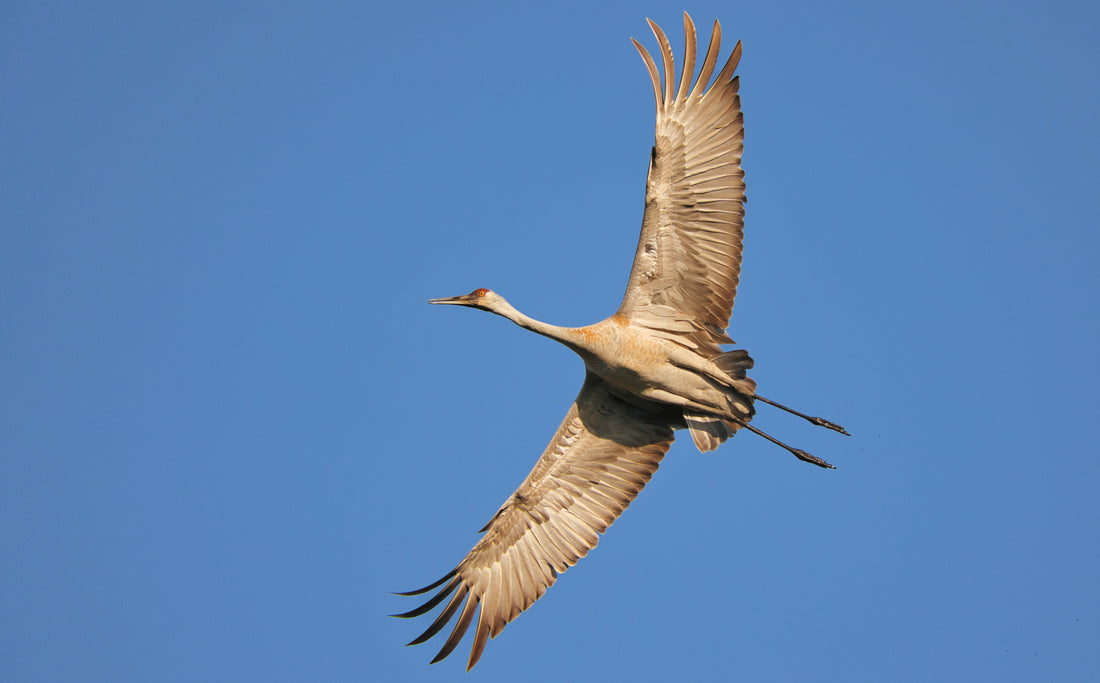Saturday, March 23rd, 2024 was a beautiful crisp morning with the air full of the calls of migratory birds moving north for the spring. Unseasonably warm weather triggered the move north early for many wildlife species where early nesting signifies a reaction to the phenological change. An avid birder and former Board Member for the Wisconsin Society for Ornithology, Quentin Yoerger, was walking the trails at Three Waters Reserve when he spotted a Sandhill Crane nesting on site and reported it to Reserve staff.

Photo: Parent Sandhill Crane sitting on the nest site at Three Waters Reserve. The parent on the nest remained still and alert as staff made observations of the nest location. The other parent was spotted walking around in the marsh watching the nest and staff. The successful nest, built on a floating mat of emergent vegetation, endured several spring flooding events.
Impactful Change Recognized by Wildlife
Having spent the last century as the Decatur Lake Country Club and Golf Course, the land at Three Waters Reserve has undergone significant ecological restoration. These changes have improved the native landscape enough to now support the return of these prehistoric creatures. The oldest known fossil of a Sandhill Crane is dated to be 2.5 million years old.
The landscape of the Reserve is the perfect habitat for Sandhill Crane nesting as they stake out land that is an open wetland surrounded by trees. The Reserve provides the perfect balance of wet, dry, grassy, open, and covered landscapes to offer protection and food for a growing crane family.
Staff went quickly to work by temporarily closing trails around the nesting site, creating land management plans to give the cranes proper space during nesting (mom and dad get very territorial with their nest and babies), consulting with crane experts from the region, and collecting data for our onsite Field Station to further the research that is being conducted at the Reserve.

Photo: Executive Director Swann installing a trail-closed sign to block off access to the nesting area.
The Clutch
In most cultures, the sighting of a crane signals good luck, wealth, prosperity, health, longevity, vigilance, and loyalty. All signs we welcome here at the Reserve.
To our surprise, we were able to identify and observe not one, but TWO eggs in the nest. An Average clutch ranges from 1-3 eggs in size and typically only one egg survives and hatches.
As time moved on observations were taken. Snow and torrential rain increased the water level around the eggs. While cranes are experts at finding their ideal habitat with standing water to protect themselves from predators, it had us holding our breath as we watched the carefully chosen nesting site rise and fall with the weather patterns.

Photo: Pictured above are the two Sandhill Crane eggs the nesting pair laid at the Reserve.
We were cautiously optimistic about the chances of survival for the eggs. After consulting with experts from the International Crane Foundation, we continued to monitor the family from a distance and began counting down the days to the anticipated hatch date.
Sandhill Crane eggs are approximately 3.6 inches long and 2.3 inches wide. They range in color from olive to pale brown, with brown markings. The incubation period lasts between 29 and 32 days.
Tracking the incubation period, we kept our eyes peeled and ears open for any crane activity. Each morning arriving at the Reserve for work, SWLC President Steve Apfelbaum would listen and hear the unison call sent out by the cranes.
Sandhill Cranes make over 20 different vocalizations to communicate a variety of different needs and situations. This unison call is unique, made not only to protect their territory, but also to strengthen their bond with one another. The sound from this unison call can travel up to 2.5 miles and is reminiscent of prehistoric wildlife. You can hear some of their vocalizations here.

Photo: The mother Sandhill Crane on the nest with the first hatched colt peering over her shoulder.
4/21/2024 Hatch Day!
The day we had all been waiting for! Wildlife photographer, Craig Ellefson was visiting the Reserve and was lucky enough to witness the parent sitting on the nest with a colt, a baby crane, at its side.
While we did not capture photos, we were able to observe the parents with binoculars with TWO hatched, healthy, and active colts.
Within 8 hours of hatching, colts are able to not only walk, but can swim! While we did not capture this transition from the nest to land, within a day of hatching the twins transitioned to land with the parents! This was an important step for safety and food sourcing for the twins to survive.

Photo: A parent Sandhill Crane with one of the colt twins camouflaged in the wetland grasses.
Camouflage at its Finest
The tall grasses at the Reserve serve as the perfect refuge for the colts and the parents. If the parents sense danger, an alarm call is sounded off to nearby colts. The significance of this call is paramount to alert colts to drop into the grass and stop moving.
Throughout the summer we had very sporadic sightings of the twins and the parents. As the grasses grew in, the cranes disappeared into their wild fortress on the Reserve.
When we did spot red heads bobbing through the grasses, there was space between the parents. One SLWC Board Member, spent several years as a volunteer at the International Crane Foundation in Baraboo. While at ICF, they were a "Chick Mom" and offered insight to this behavior.
"In the case of twins when the food source is good, each parent with normally take a colt and strut around with it teaching it to feed. If the food supply is scant, they will let one chick take over and both parents will feed the stronger of the two chicks resulting in the passing of the weaker one. It is sad, but that is nature. While volunteering as a chick mom at ICF, one of our responsibilities was to keep the colts from fighting with one another so they could all survive."
We feel fortunate that the Reserve offers a host of food supply options for the entire crane family. This healthy ecosystem enabled both twins to flourish.

Photo: Experts in camouflage: the parent cranes kept their colts safely hidden in the tall native grasses on the Reserve.
Why keep the nest a secret?
First and foremost, Three Waters Reserve is a nature reserve providing refuge and a safe home to all types of wildlife. The property is owned by a 501(c)3 non-profit, the Southern Wisconsin Land Conservancy. SWLC has protected the property and its wild inhabitants with a conservation easement.
Knowing and understanding the protective behavior often exhibited by parent cranes, we wanted to ensure they felt safe and secure in their nesting spot. Keeping this nest a secret also ensured that any visitors to the Reserve remained safe because they were not out looking for and potentially engaging with the crane family.

Photo: Family walk time! The crane family cruises along the trails at the Reserve, the second twin had already rounded the corner when this picture was snapped.
Saying Farewell
Cranes begin to stage for migration south in November and typically leave for Florida by December. Sandhill Cranes typically travel 200-300 miles per day and up to 500 miles with the right winds.
We will miss this family with their twins when they depart in the fall. However, as the family grows and prepares for migration, we reflect, hoping they will remember their time here on the Reserve, and maybe this crane family will come back and visit us in the near future.
"Magic birds were dancing in the mystic marsh. The grass swayed with them, and the shallow waters, and the earth fluttered under them. The earth was dancing with the cranes, and the low sun, and the wind and sky."
-Marjorie Kinnan Rawlings

Photo: A parent Sandhill Crane (left) with one of the twin colts (right). The adult has a fully colored red and grey head, the colt is starting to color up and losing its brown chick coloring.
Interested in More?
If you would like to learn more about Sandhill Cranes check out these links:
International Crane Foundation in Baraboo, WI
If you would like to support the conservation work being done by the Southern Wisconsin Land Conservancy at Three Waters Reserve and other sites, please consider becoming an SWLC member, or making a donation.


